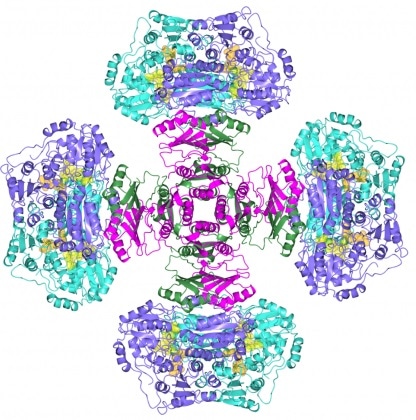Scientists from the University of Queensland have successfully solved a five-decade-old mystery that may lead to sophisticated herbicides and treatments for infections.

This information provides new insights into an important enzyme—acetohydroxyacid synthase—a target for more than 50 commercial herbicides. Image Credit: The University of Queensland.
Headed by the University of Queensland Professor Luke Guddat, the research team disclosed the entire 3D structure of an enzyme, offering the initial step in the biosynthesis of valine, leucine, and isoleucine—three essential amino acids.
This is a major scientific advance, which has been pursued globally by chemists for half a century. This information provides new insights into an important enzyme—acetohydroxyacid synthase—a target for more than 50 commercial herbicides. It’s also a potential target for new drugs to treat infections such as tuberculosis and invasive Candida infections.”
Luke Guddat, Professor, University of Queensland
The researchers used sophisticated technologies like X-ray crystallography and cryo-electron microscopy to interpret the structure of the fungal and plant versions of the enzyme.
We identified how this highly complex structure is assembled, which is the highly unusual shape of a Maltese Cross. Coincidently, the Maltese Cross also features as a part of UQ’s logo.”
Luke Guddat, Professor, University of Queensland
Professor Guddat added that the finding could have huge prospects for worldwide agriculture.
Sulfometuron is a herbicide that targets this enzyme, and was widely used in the 1990s for wheat crop protection throughout Australia. But today it is completely ineffective due to the development of resistance. With this new insight, we will be able to make changes to existing herbicides, restoring options for future herbicide application.”
Luke Guddat, Professor, University of Queensland
Guddat further added that the enzyme was found only in microorganisms and plants and not in human beings.
“For this reason, the herbicides and drugs that it targets are likely to be safe and non-toxic to all mammals. And another surprising finding of the research was the role that the molecule known as ATP plays in the regulation of the enzyme,” he further stated.
“Normally ATP plays a role in providing energy to all living cells. However, here it is acting like a piece of glue to hold the structure together. They’re fascinating findings for us, and we’re excited for new opportunities for targeted design of next-gen herbicides and antimicrobial agents,” Professor Guddat concluded.
Source:
Journal reference:
Lonhienne, T., et al. (2020) Structures of fungal and plant acetohydroxyacid synthases. Nature. doi.org/10.1038/s41586-020-2514-3.